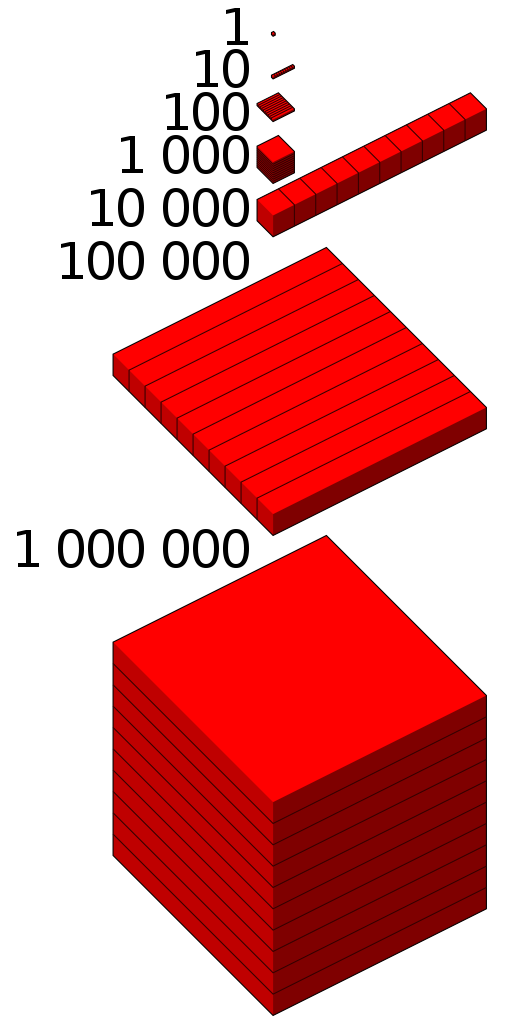 |
| By Cmglee - Own work, CC BY-SA 3.0, https://commons.wikimedia.org/w/index.php?curid=15449760 |
- Information: Not counting spaces, the text printed on 136 pages of an Encyclopædia Britannica, or 600 pages of pulp paperback fiction contains approximately one million characters.
- Length: There are one million millimeters in a kilometer, and roughly a million sixteenths of an inch in a mile. A typical car tire might rotate a million times in a 1,200-mile (1,900 km) trip, while the engine would do several times that number of revolutions.
- Fingers: If the width of a human finger is 2.2 cm (7⁄8 in), then a million fingers lined up would cover a distance of 22 km (14 mi). If a person walks at a speed of 4 km/h (2.5 mph), it would take them approximately five and a half hours to reach the end of the fingers.
- Area: A square a thousand objects or units on a side contains a million such objects or square units, so a million holes might be found in less than three square yards of window screen, or similarly, in about one half square foot (400–500 cm2) of bed sheet cloth. A city lot 70 by 100 feet is about a million square inches.
- Volume: The cube root of one million is only one hundred, so a million objects or cubic units is contained in a cube only a hundred objects or linear units on a side. A million grains of table salt or granulated sugar occupies only about 64 ml (2.3 imp fl oz; 2.2 US fl oz), the volume of a cube one hundred grains on a side. One million cubic inches would be the volume of a small room only8 1⁄3 feet long by 8 1⁄3 feet wide by 8 1⁄3 feet high.
- Mass: A million cubic millimeters (small droplets) of water would have a volume of one litre and a mass of one kilogram. A million millilitres or cubic centimetres (one cubic metre) of water has a mass of a million grams or one tonne.
- Weight: A million 80-milligram (1.2 gr) honey bees would weigh the same as an 80 kg (180 lb) person.
- Landscape: A pyramidal hill 600 feet (180 m) wide at the base and 100 feet (30 m) high would weigh about a million tons.
- Computer: A display resolution of 1,280 by 800 pixels contains 1,024,000 pixels.
- Money: A USD bill of any denomination weighs 1 gram (0.035 oz). There are 454 grams in a pound. One million $1 bills would weigh 2,204.62 pounds (1,000.00 kg), or just over 1 ton.
- Time: A million seconds is 11.57 days.
Just in case you were wondering, the smallest seven digit prime number is 1,000,003.
One of the most common questions I hear from non-genealogists is "How far back does your genealogy go?" The second most common question is "How many names do you have your files?" Of course, if you have been doing genealogy for any length of time you realize that both questions are entirely meaningless. From my standpoint, accuracy is far more important than the size of the file. I have repeated my standing challenge hundreds of times that there is not one family pedigree that I have examined but does not have serious errors in places or dates including my own files.
We are currently discussing the issue of purchasing a newer computer as I have mentioned it previous posts. One of my concerns is that over the years I have been purchasing computers with the expectation that they would be faster and more efficient than the previous models. Unfortunately, with the huge number of files on my computer I have no assurance that a faster computer will actually process the information any faster. The limitations on working with the size of the database revolve around the time it takes to move the information through the system and I suspect that the ultimate limitation will be the speed of the connections I have to my external hard drives.
Meanwhile, it's time to get back to work.




No comments:
Post a Comment